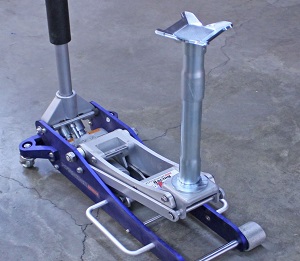
The need for a jack, particularly when lifting a car, can’t be overstated. When it comes time to replace brake pads, tires, or even oil, having this tool is a must. Although the car is equipped with a scissor jack, it is hard to use.
A floor jack, on the other hand, is useful in a variety of scenarios. Floor jacks can be utilized, but they must be used correctly to avoid injury. Floor jack extenders are needed in this situation. The proper way to utilize a jack floor extension will now be discussed.
Steps for using a Floor Jack Extender
Make sure you know how to properly operate the floor jack extender once you have it. Here are the specifics on how to use a floor jack extender, step by step.
Use a flat surface
It’s a simple chore to use a floor jack to lift a vehicle. To begin, you need to locate a level surface. Once you’ve got a custom-made or store-bought floor jack saddle, you can raise and lower your car with ease. To guarantee that the task is done safely and effectively, examine the working environment.
Chock various tires
Following the detection of an even surface, the second stage is the most critical. You must secure all of the tires which will not be raised using straps or chains. To do this, gently slide the jack beneath the automobile until it makes contact with the inside of the vehicle’s body. The jack supports should be properly aligned before carefully raising the vehicle off the ground.
Make necessary adjustments to the jack
As in other circumstances, the extension must be positioned to maximize stability. To elevate the car, locate the jack component and move it to where you need it to be. This is important and if the saddle had been moved off-center, things might not have gone well.
Pump the handle to release the pressure
Proper working height may be achieved by slowly pumping the handle until a solid contact is made. The jack extender comes in a variety of designs. Depending on the model, you may need more or fewer pumps to achieve the desired height. Lifting or getting ready for work may just need three pumps for some.
If the extension saddle on the floor jack starts to crush the load, look at the jack’s lifting mechanism. Stability and minimal lateral stresses are key considerations. In extreme cases, the automobile might tumble off the jacks while the extension is still attached.
Make sure the car is brought down to the ground
The next step is to lower the jack extension, which is just as simple as raising it in the first place. To use the floor jack extender to bring the car down is now the inverse of this way of bringing the vehicle up. Keep in mind that there is a possibility of injury while using a jack extender.
As a result, prepare well before commencing the method, and then carry out the task with ease once it has begun. The device is not suitable with all sorts of jack models; it’s also a good way to consider a floor raise pad. In any case, you will have had the most enjoyable lifting session you have ever had.
Conclusion
The need for a jack, particularly when lifting a car, can’t be overstated. A floor jack is useful in a variety of scenarios but must be used correctly to avoid injury. Here are the specifics on how to use a floor jack extender, step by step. Proper working height may be achieved by slowly pumping the handle until a solid contact is made. Stability and minimal lateral stresses are key considerations. The jack extender comes in a variety of designs, depending on the model, you may need more or fewer pumps to achieve the desired height.
- Craftsman Jack Stands Review - October 18, 2022
- OTC 1545 Motorcycle Lift Review - October 18, 2022
- Pro Lift Jack Stand Review - October 17, 2022
